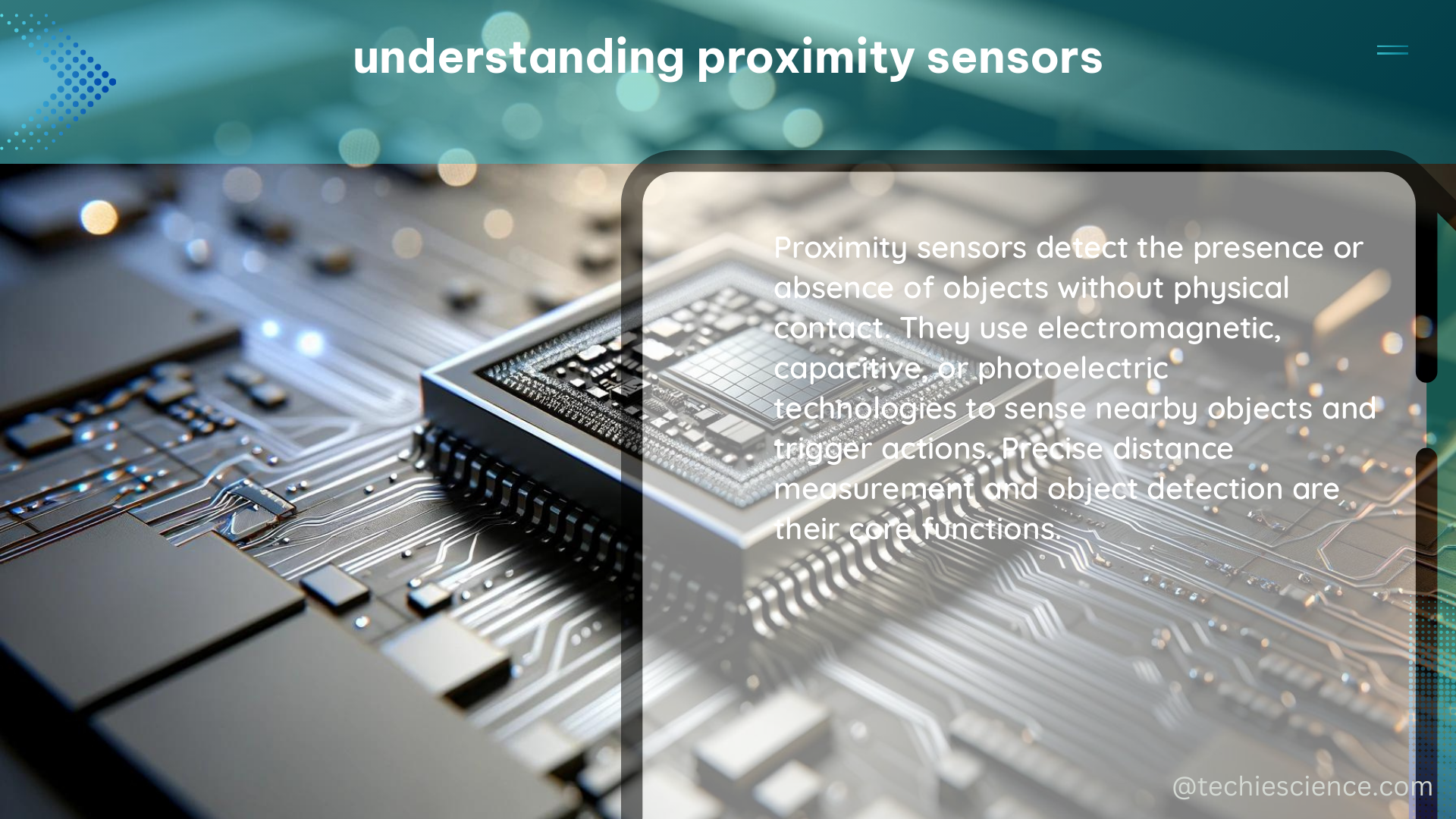Proximity sensors are versatile devices that detect the presence or absence of an object within a specific range without physical contact. These sensors are widely used in various applications, including industrial automation, robotics, healthcare, and beyond. Understanding the different types, working principles, and technical specifications of proximity sensors is crucial for selecting the right sensor for a particular application.
Types of Proximity Sensors
Proximity sensors can be categorized into four main types based on their operating principles:
- Inductive Proximity Sensors:
- Operate by generating an electromagnetic field to detect the presence of metallic objects.
- Suitable for detecting ferrous and non-ferrous metals, such as steel, aluminum, and copper.
- Have a typical sensing range of 1 to 60 mm, depending on the sensor size and the target material.
- Offer a long service life due to the absence of mechanical parts.
-
Cannot detect non-metallic objects.
-
Capacitive Proximity Sensors:
- Measure the change in capacitance between the sensor and the target object.
- Can detect both metallic and non-metallic objects, including liquids and powders.
- Typical sensing range of 2 to 30 mm, depending on the sensor size and the target material.
-
Sensitive to environmental factors, such as temperature and humidity, which can affect their performance.
-
Ultrasonic Proximity Sensors:
- Use high-frequency sound waves to detect the presence of objects.
- Can detect both metallic and non-metallic objects.
- Offer a long detection range, typically from 20 mm to 10 meters, depending on the sensor model.
-
Sensitive to noise and temperature changes, which can impact their accuracy.
-
Infrared (IR) Proximity Sensors:
- Utilize infrared light to detect the presence of objects.
- Can detect both metallic and non-metallic objects.
- Typical sensing range of 10 mm to 2 meters, depending on the sensor model.
- Sensitive to ambient light changes, which can affect their performance.
Technical Specifications of Proximity Sensors

When selecting a proximity sensor, it is essential to consider the following technical specifications:
- Sensing Range: The maximum distance at which the sensor can reliably detect an object.
- Operating Frequency: The frequency at which the sensor operates, typically ranging from kHz to MHz.
- Response Time: The time it takes for the sensor to detect an object and provide an output signal, typically in the range of microseconds to milliseconds.
- Output Type: The type of output signal the sensor provides, which can be analog (e.g., 4-20 mA) or digital (e.g., NPN, PNP).
- Environmental Factors: Factors such as temperature, humidity, and vibration that can affect the sensor’s performance and should be considered during the selection process.
Sensor Selection Considerations
When choosing a proximity sensor for a specific application, consider the following factors:
- Application Requirements: Understand the specific needs of the application, such as the type of objects to be detected, the required sensing range, and the environmental conditions.
- Sensor Characteristics: Evaluate the technical specifications of the sensor, such as sensing range, response time, and output type, to ensure they match the application requirements.
- Environmental Factors: Consider the environmental conditions, such as temperature, humidity, and vibration, and select a sensor that can withstand these conditions.
- Cost and Availability: Determine the budget and availability of the sensor, as well as any additional costs associated with installation and maintenance.
- Integration Capabilities: Assess the sensor’s ability to integrate with the existing system or control infrastructure, including communication protocols and software compatibility.
Proximity Sensor Applications
Proximity sensors have a wide range of applications beyond industrial automation and robotics, including:
- Healthcare: Monitoring patient vital signs, such as respiratory rate, wound healing, and patient presence in beds or chairs.
- Automotive: Detecting the presence of objects, such as vehicles or pedestrians, for collision avoidance and parking assistance systems.
- Smart Home: Detecting the presence of people or objects for automated lighting, security, and energy management systems.
- Agriculture: Monitoring the level of liquids or granular materials in silos and tanks.
- Logistics: Detecting the presence of packages or pallets for inventory management and automated material handling.
Integrating Proximity Sensors with Machine Learning
Proximity sensors can be further enhanced by integrating them with machine learning algorithms. This integration can improve the sensor’s performance and provide valuable insights into various applications. For example, a machine learning algorithm can be trained to recognize patterns in a patient’s vital signs and alert healthcare professionals if there are any abnormalities, leading to early detection of health issues and improved patient outcomes.
Conclusion
Proximity sensors are versatile devices that play a crucial role in a wide range of applications, from industrial automation to healthcare. Understanding the different types of proximity sensors, their technical specifications, and the factors to consider during the selection process is essential for choosing the right sensor for a particular application. By integrating proximity sensors with machine learning algorithms, their performance can be further enhanced, leading to improved efficiency, safety, and patient care.
References
- Proximity Sensors: Types, Working Principle, and Applications
- Understanding Proximity Sensors
- Proximity Sensor Technical Specifications
- Capacitive Proximity Sensors for Respiratory Rate Monitoring
- Ultrasonic Proximity Sensors for Wound Monitoring
- Infrared Proximity Sensors for Patient Presence Detection
- Machine Learning for Proximity Sensor Performance Enhancement

The lambdageeks.com Core SME Team is a group of experienced subject matter experts from diverse scientific and technical fields including Physics, Chemistry, Technology,Electronics & Electrical Engineering, Automotive, Mechanical Engineering. Our team collaborates to create high-quality, well-researched articles on a wide range of science and technology topics for the lambdageeks.com website.
All Our Senior SME are having more than 7 Years of experience in the respective fields . They are either Working Industry Professionals or assocaited With different Universities. Refer Our Authors Page to get to know About our Core SMEs.